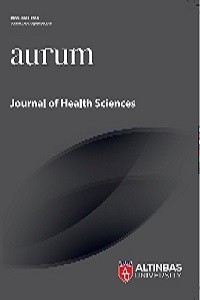A NEW METHOD BASED CNN COMBINED WITH GENETIC ALGORITHM AND SUPPORT VECTOR MACHINE FOR COVID-19 DETECTION BY ANALYZING X-RAY IMAGES
COVID-19, Genetic algorithm, SVM, CNN
___
- Afshar, P., S. Heidarian, F. Naderkhani, A. Oikonomou, K.N. Plataniotis, A. Mohammadi et al., “-Caps: A Capsule Network-Based Framework for Identification of COVID- 19 Cases from X-Ray Images”. ArXiv Prepr ArXiv200402696 2020:1–4.
- Batık, Z., G. Atalı, D. Karayel, and S. S. Özkan, “Using heuristic distance functions in path planning of mobile robots,” Electronics World, pp. 34–36, Oct. 2018. World Health Organization (WHO) - https://www.who.int/emergencies/diseases/novel-coronavirus-2019 (accessed at Feb 24, 2020).
- Chen, N., M. Zhou, X. Dong, J. Qu, F. Gong, Y. Han et al., “Epidemiological and Clinical Characteristics of 99 cases of 2019 Novel Coronavirus Pneumonia in Wuhan, China: A Descriptive Study”. Lancet - 2020, 10.1016/S0140-6736(20)30211-7.
- Chowdhury, M.E.H., T. Rahman, A. Khandakar, R. Mazhar, M.A. Kadir, Z.B. Mahbub et al., “Can AI Help in Screening Viral and COVID-19 Pneumonia?” ArXiv 200313145 2020.
- Diprose J, MacDonald B, Hosking J, Plimmer B. Designing an API at an appropriate abstraction level for programming social robot applications. J. Vis. Lang. Comput., 2017;39,22–40.
- Farooq, M., A. Hafeez, “COVID-ResNet: A Deep Learning Framework for Screening of COVID19 from Radiographs”, ArXiv:2003.14395, 2020.
- Gao, Z. Zeng, X. Wang, J. Liu, J., 2008. FPGA implementation of adaptive IIR filters with particle swarm optimization algorithm. Communication Systems.
- Huang, C., Y. Wang, X. Li, L. Ren, J. Zhao, Y. Hu et al., “Clinical Features of Patients Infected with 2019 Novel Coronavirus in Wuhan”, China. Lancet - 2020.
- Karim A.M., Mishra A. (2022) Novel COVID-19 Recognition Framework Based on Conic Functions Classifier. In: Garg L., Chakraborty C., Mahmoudi S., Sohmen V.S. (eds) Healthcare Informatics for Fighting COVID-19 and Future Epidemics. EAI/Springer Innovations in Communication and Computing. Springer, Cham. https://doi.org/10.1007/978-3-030-72752-9_1.
- Li, Q., X. Guan, P. Wu, X. Wang, L. Zhou, Y. Tong et al., “Early Transmission Dynamics in Wuhan, China, of Novel Coronavirus-Infected Pneumonia”. The New England Journal of Medicine. 2020.
- Li, X., D. Zhu, “COVID-Xpert: An AI Powered Population Screening of COVID-19 Cases Using Chest Radiography Images”. ArXiv:200403042 2020:1–6.
- Yin, A.Y., R.G. Wunderink, “MERS, SARS and Other Coronaviruses as Causes of Pneumonia”, Respirology, 23 (2018), pp. 130-137).
- Wang, D., B. Hu, C. Hu, F. Zhu, X. Liu, J. Zhang et al., “Clinical Characteristics of 138 Hospitalized Patients with 2019 Novel Coronavirus-Infected Pneumonia in Wuhan”, China. Jama - 2020.
- ISSN: 2651-2815
- Yayın Aralığı: Yılda 3 Sayı
- Başlangıç: 2018
- Yayıncı: Altınbaş Üniversitesi
BUILDING AN ELECTRONIC HEALTH PORTAL WITH AN E-HEALTH APPLICATION TO COMMUNICATE WITH PATIENTS
Ali AL FAZEA, Abdullahi Abdu IBRAHİM
DETECTION OF COVID-19 IN LOW ENERGY CHEST X-RAYS USING FAST R-CNN
Maryam Kareem Sakran MAMOORİ, Abdullahi Abdu IBRAHİM
DETECTION OF COVID-19 PNEUMONIA EFFECTS IN CHEST X-RAYS USING DEEP LEARNING
